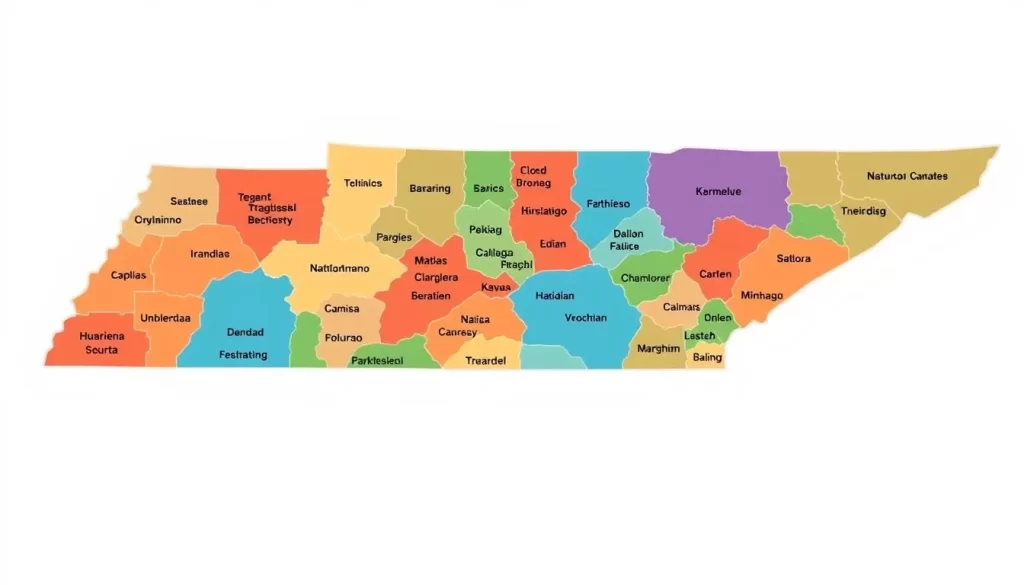As you explore the Volunteer State, you’ll discover a rich tapestry of languages spoken by its residents. With a population of approximately 7.05 million, Tennessee is home to a diverse community, where around 521,799 residents speak a language other than English at home.
This linguistic diversity is a result of centuries of immigration, from early European settlers to more recent arrivals from Latin America and Asia. As a result, about 2.82% of the population, or 198,848 residents, are considered to have limited English proficiency.
Understanding this linguistic landscape is crucial for businesses, healthcare providers, and government agencies seeking to serve all residents effectively. Whether you’re planning to visit, relocate, or simply interested in Tennessee’s cultural makeup, this guide will provide valuable insights into the state’s language demographics.
The Linguistic Landscape of Tennessee
As you explore Tennessee, you’ll discover a state with a multifaceted language profile. The state’s linguistic diversity is shaped by its history, cultural influences, and demographic changes.
Overview of Language Diversity in the Volunteer State
Tennessee’s linguistic landscape reflects both its historical development and recent demographic shifts, creating a diverse tapestry of languages across the state. The Volunteer State, while predominantly English-speaking, hosts communities speaking dozens of different languages, from Spanish to Arabic to Chinese and beyond. Urban areas like Nashville, Memphis, and Knoxville typically show greater linguistic diversity than rural regions.
Percentage of Non-English Speakers in Tennessee
Approximately 7.4% of Tennessee residents over age four speak a language other than English at home, representing about 521,799 people out of the state’s 7.05 million population. Among these non-English speakers, about 2.82% of Tennessee’s total population (approximately 198,848 residents) have limited English proficiency (LEP), meaning they face challenges communicating in English.
| Category | Percentage | Number of Residents |
|---|---|---|
| Non-English Speakers | 7.4% | 521,799 |
| Limited English Proficiency (LEP) | 2.82% | 198,848 |

English as the Official Language of Tennessee
As you explore the linguistic landscape of Tennessee, you’ll find that English has been the cornerstone of official communications. This is not a coincidence, but a result of legislative actions and historical developments that have shaped the state’s language policies.

Legal Status of English in Tennessee
The legal status of English in Tennessee reflects both practical considerations and cultural identity, establishing it as the language of government, education, and official communications. While the state recognizes English as its official language, this designation doesn’t prohibit the use of other languages in private communications, businesses, or cultural contexts. Tennessee’s official language policy has implications for government services, educational curricula, voting materials, and other official functions throughout the U.S. state.
Understanding the legal status of English in Tennessee provides context for how language services are structured and delivered across the state’s public institutions, playing a crucial role in maintaining English proficiency among its population.
When and How English Became the Official Language
Tennessee, like many other states in the United States, has officially designated English as its state language through legislative action. The process by which English became Tennessee’s official language involved legislative debate and consideration of the state’s historical development since its admission to the United States in 1796. Despite English’s official status, Tennessee’s approach to language diversity continues to evolve as the state’s population becomes increasingly multicultural and multilingual.
The balance between maintaining an official language while accommodating linguistic diversity represents an ongoing conversation in Tennessee’s public policy development, affecting various communities within the state and influencing the need for translation services.
Tennessee’s Immigration History and Its Impact on Languages
The Volunteer State’s linguistic diversity is a direct result of the different immigrant groups that have settled there over the centuries. As you explore the history of Tennessee, you’ll discover that the state’s language landscape has been shaped by various waves of immigration.
18th and 19th Century European Settlement
During the 18th century, Europeans began settling in the area that is now Tennessee. Many of the earliest immigrants were of English and Scotch-Irish descent, though there was also a sizeable German population. The region was initially populated by indigenous people, including the Cherokee and Chickasaw, who were ultimately relocated.
The 19th century saw the African population grow rapidly due to the forced migration of enslaved Africans for agricultural labor. This period significantly impacted the linguistic landscape, contributing to the development of distinctive dialects and speech patterns.
20th Century Population Shifts
The 20th century brought new waves of immigrants to Tennessee, diversifying the state’s linguistic landscape. The Hispanic population in Tennessee grew significantly, introducing Spanish to many parts of the state. Additionally, communities of immigrants from Asia began to form.
21st Century Immigration Patterns
In the 21st century, Tennessee has experienced increased immigration from Asia, Latin America, and the Middle East. This has brought languages like Vietnamese, Arabic, and Korean to communities across the region. The result is a rich tapestry of language and culture.

Top 10 Languages Spoken in Tennessee Besides English

The Volunteer State boasts a rich tapestry of languages, with a significant number of residents speaking languages other than English. This diversity is a reflection of the state’s cultural heritage and its position within the global community.
Spanish: Tennessee’s Most Prevalent Non-English Language
Spanish is the most widely spoken non-English language in Tennessee, with approximately 264,534 speakers, representing about 4.16% of the state’s population. This significant presence is a result of historical and contemporary migration patterns.
Arabic: The Second Most Common Non-English Language
Arabic is the second most common non-English language, spoken by an estimated 26,921 residents, or 0.42% of the population. This reflects the growing Middle Eastern communities, particularly in urban areas.
Chinese (Including Mandarin and Cantonese)
Chinese languages, including both Mandarin and Cantonese, rank third with around 15,351 speakers, or 0.24% of the population. These communities are often centered around universities and technology sectors.
German and French Speakers in Tennessee
German and French maintain historical presences in Tennessee, with approximately 10,776 German speakers and 10,625 French speakers, each representing just under 0.17% of the state’s population.
Vietnamese and Korean Communities
Vietnamese has established a significant presence with about 9,457 speakers, or 0.15% of the population, while Korean follows closely with 8,065 speakers, or 0.13%. Both languages reflect post-1970s immigration patterns.
Gujarati and Tagalog Speakers
South Asian languages are well-represented through Gujarati, spoken by approximately 7,631 Tennessee residents, or 0.12% of the population. Filipino immigrants have brought Tagalog to Tennessee, with around 7,442 speakers, or just under 0.12% of the population.
Thai, Lao, and Other Tai-Kadai Languages
Southeast Asian languages round out the top ten with Thai, Lao, and other Tai-Kadai languages spoken by approximately 7,116 residents, or 0.11% of the population.
Other Notable Language Communities in Tennessee
Beyond the top ten, Tennessee hosts speakers of dozens of other languages, including Japanese, Hindi, Russian, and various African languages, creating a rich linguistic diversity across the state.
Limited English Proficiency in Tennessee
Approximately 2.82% of Tennessee’s residents face challenges due to limited English proficiency. This demographic is a significant part of the state’s diverse population, and understanding their needs is crucial for providing effective services.
Statistics on LEP Population
The limited English proficiency (LEP) population in Tennessee is substantial, with about 198,848 residents struggling to communicate effectively in English. This group is not evenly distributed across the state; instead, they tend to concentrate in urban areas and communities with higher immigrant populations.
To better understand the scope, let’s look at some key statistics:
| Category | Numbers | Percentage |
|---|---|---|
| Total LEP Population | 198,848 | 2.82% |
| LEP in Urban Areas | 120,000 | 60% |
| LEP with No English Ability | 45,000 | 22.6% |
Language Access Services and Resources
You can access various language services and resources in Tennessee to cater to the LEP population. Acutrans is one such provider, offering industry-leading language services covering over 200 languages. Their services include on-site, over-the-phone, or video remote interpretation programs, ensuring that you can address nearly any interpretation need.
Some of the key services available include:
- Certified document translations available within 24 hours or less
- Specialty services for the legal and healthcare sectors
- Localization and post-machine translation programs

By leveraging these services, you can ensure compliance with federal civil rights laws and provide meaningful access to your services for LEP individuals. This is particularly important in healthcare and legal settings, where precise communication is critical.
Conclusion: The Importance of Linguistic Diversity in Tennessee
As we conclude our exploration of Tennessee’s linguistic landscape, it’s clear that the state’s language diversity is a significant aspect of its cultural identity. The growing number of non-English speakers has contributed to the state’s cultural and economic development.
For businesses and healthcare providers in Tennessee, recognizing and accommodating language diversity can open new markets and strengthen community relationships. Professional translation and interpretation services play a crucial role in bridging communication gaps and ensuring equal access to essential services for all Tennessee residents.
As Tennessee continues to attract immigrants and international businesses, the state’s linguistic diversity will likely continue to grow. Understanding the languages spoken in Tennessee helps organizations better serve their communities and celebrates the cultural richness that multiple language traditions bring to the Volunteer State.
The above is subject to change.
Check back often to TRAVEL.COM for the latest travel tips and deals.






